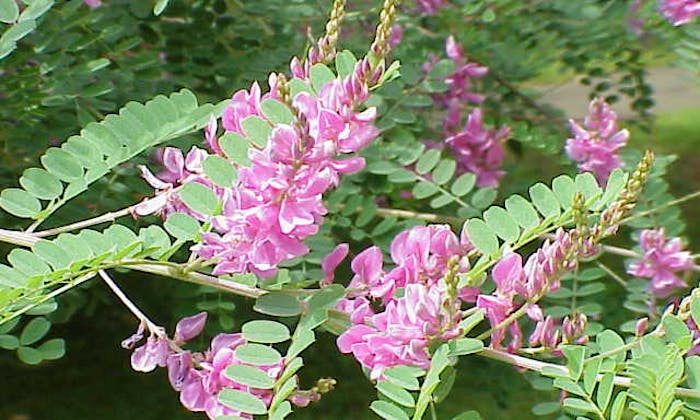Indigo was once a popular natural dye, providing the name to the color. Today it makes for an interesting ornamental plant and acts as a soil builder.
There are a number of different plant species that can be called "indigo," most of them share a genera, Indigofera. There is even a North American native plant, called "False Indigo" (Amorpha fruticosa). The plant most commonly called "indigo" and most often used for dye is Indigofera tinctoria. That is the plant we care about here.
History
Also called "true indigo", the indigo plant is a small shrub, and can even be grown as a spreading groundcover. It is a member of the legume family (Faabaceae) and is nitrogen fixing. It's a sun and heat loving plant that does very well in California's dry weather. It is a zone 9-10 plant.
Indigo has been cultivated for so long, it is not clear exactly where it originated. It g is naturalized to tropical part of Asia as well as some parts of Africa.
Indigo was brought to Europe by Marco Polo, after he came across it being used in India. After that, it became an important color in European easel painting, during the Middle Ages.
How to Make Indigo Dye
For many plant-based dyes, the process of dying is straightforward. Not so with Indigo. Before indigo can be used for dying, it has to go through a fermentation process.
A large amount of indigo leaves are collected. The leaves are pulverized and added to ground madder. Madder is a source of red dye, in this case it is used as a starter, like making sourdough bread. The madder contains the bacteria needed to ferment the indigo dye.
The process takes about a week, but because of the fermentation involves no dangerous chemicals.
Check out this page for detailed instructions on dying with indigo.
Growing the Indigo Plant
Indigo can be grown as an annual in colder climates, but does best in Zone 9 and above where it can be grown as a perennial.
Indigo prefers well-draining, fertile soil, so mix in lots of compost or worm castings. For the most part, indigo wants lots of sunlight, but avoid too much direct sunlight in the middle of the day. If you are growing from seed, indigo can take a few years before it flowers.
Indigo does best in tropical climates. It will need supplemental water in dry weather, but does not like to sit in wet soil. Indigo has sensitive roots and does not like to be transplanted frequently. If growing from seed, start in a larger container, such as a four inch pot, to avoid having to transplant too many times.
Harvesting
Harvesting indigo is something you might do if you plan to dye with it. Although the flowers can be a colorful pink to blue color, it is the leaves that provide the dye.
You want to harvest the leaves when they contain the most glycoside indican, the precursor to the blue dye. Glycoside indican is at it's highest levels just before the flowers open up. The leaves will be an ordinary green color, not blue.
If you are growing indigo as a perennial, make sure to leave at least half of the leaves on the plant. Any more and you may kill it.

